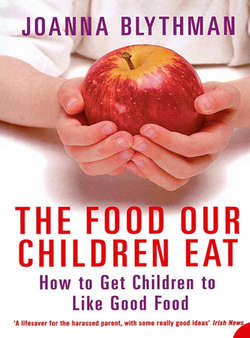Читать книгу The Food Our Children Eat: How to Get Children to Like Good Food - Joanna Blythman, Joanna Blythman - Страница 9
‘PICKY-EATER’ CULTURE
ОглавлениеThese days, more adults than ever before seem to have inordinate difficulty getting their children to eat a reasonably wide range of good, wholesome food. Why do we live in a land where children seem drawn only to food that is bad for them?
It’s a curious modern phenomenon. British and American children seem to be bonded by a common culture that fosters resistance to good food. They stand out from children in other parts of the world with more traditional food cultures, even Europe. Most Italians would throw up their hands in horror at the very idea of a child who would not eat vegetables. In the UK we shrug our shoulders and say, reluctantly, that this is normal. In France, sales of crisps rely on adults serving them with drinks as an aperitif. It would be an eye-opener to most French people to witness the hordes of U K schoolchildren walking to and from school with bags of crisps and fizzy drinks. In fact it seems that wherever Anglo-American food culture becomes strong, a liking for junk food and a problematic attitude towards good food follow. Within this type of food culture there has been a population explosion of ‘picky eaters’. When once the infamous picky eaters were the exception, now they are the rule.
How can this be? There are lots of theories ploughing both sides of the nature-nurture divide. One belief is that junk food is basically so appealing that once children have tasted it that is all they will want: it is just a matter of time until those other traditional food countries follow suit.
Listen to the powerful transnational companies that run the food industry and you might believe that it had absolutely nothing to do with creating those modern legions of picky eaters. They say that they are simply servicing a need for popular food. If children are eating badly, then that is their parents’ fault for not balancing their diet. There is no such thing as an unhealthy food, they tell us, just an unhealthy diet.
Working mothers are another ‘usual suspect’, often asked to carry the can for children’s deteriorating food habits. We are told that because women now work (in three out of every five families where the parents are married, women have jobs), this has led to the erosion of family meals and real food in favour of more convenient processed food. So grazing has taken over from three square meals, leading to ever more reliance on anything that is quick to prepare and comes in single units of food that can be eaten as required. Junk food fits the bill.
All these theories are basically fatalistic about children’s susceptibility to junk and treat it as a fact of modern life – no turning the clock back. When forced to face up to the consequences of this thinking in the form of the millions of children who now fit the picky-eater description, there is a general wringing of hands. Helpful responses come in the form of quick techno-fixes. Okay, your children don’t want to eat breakfast, so we have created breakfast bars. The fact that they are stuck together with sugar is neither here nor there.
This sort of logic is invidious and, in the long term, does nothing to help either children or the adults trying to feed them. The reality is that nowadays we live in a culture where the prevailing conditions are all going against children eating well, and the dominant expectations lead children to conform to a depressingly limited food stereotype – whether or not their parents go out to work.
The existence of major structural factors described elsewhere in this book, like rapacious advertising targeted at children and an absence of real food education, means that parents (working or otherwise) who want their children to eat well are up against it. No surprise that many of us just go with the flow and give in to negative thinking. We almost expect to have problems feeding our children before we even begin.
Despite these very tangible structural obstacles, however, there is still considerable scope for winning back children to the delights of good food. The prospects for feeding children in a better, more wholesome way are nowhere near as bleak as made out.
Yes, all children are different and there is the odd child – even a significant minority of children – who does seem to conform naturally to that picky-eater stereotype. But there is also a huge middle ground of children who, if the conditions are right, will eat something approximating to a wide-ranging and basically wholesome diet. Some children will even actively seek it out, surprising us with their adventurousness and ability to revel in the pleasures of food and the rituals of eating.
For adults who do not want to give in to the prevailing determinism that writes off children’s food prospects, Parts Two to Six of this book give workable strategies for creating the conditions in which children can learn to eat well.
